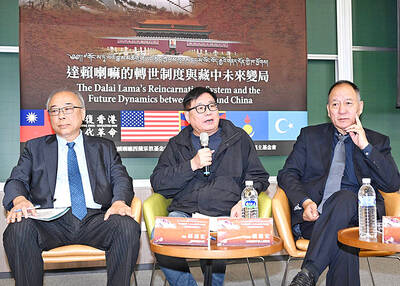China has been intensifying its military maneuvers in the region, including sending warplanes into Taiwan’s air defense identification zone (ADIZ), because the leadership in Beijing faces domestic pressure, academics said on Thursday.
Lin Ying-yu (林穎佑), an assistant professor at National Chung Cheng University’s Institute of Strategic and International Affairs, said that pressure on the leadership in Beijing has been growing, especially since it initiated large-scale military reforms in 2016.
Reforms of the People’s Liberation Army (PLA) included merging several units and scrapping others, Lin said, adding that the PLA is trying to show its members and the Chinese public that the reforms have successfully beefed up China’s military might.
The Taiwan Strait is seen as a perfect venue for the PLA to demonstrate its reformed might and for Beijing to ease internal pressure, Lin said.
As Taiwan has in the past few months strengthened its ties with the US, China’s military has raised the frequency of maneuvers in the Taiwan Strait and surrounding areas, he said, adding that this included the PLA Air Force making incursions into Taiwan’s ADIZ or crossing the Taiwan Strait’s median line.
Su Tzu-yun (蘇紫雲), a senior analyst at the Institute of National Defense and Security Research, agreed with Lin that the moves were to demonstrate strength to the Chinese public.
Crossing the Strait’s median line is an attempt to demonstrate strength, but it does not significantly increase the risk of all-out war in the region, Su said, adding that the PLA is operating in a gray area.
The PLA has also engaged in several small-scale exercises in open seas or near China’s coast, Su said, adding that these must be understood as propaganda, rather than as genuine military threats.
The crossings of the median line can also be understood as reactions to the US’ role in the region, Lin said.
The concept of the median line is thought to have been established by the US in 1954 to prevent further conflict between Taiwan and China after the Chinese Civil War had ended in 1949.
China has never openly recognized the median line, but its military rarely crossed it until Taiwan and the US increased their political and military ties.
Lin said that for many years, Taiwan and China have both tacitly recognized the line, and the PLA’s willingness to break this consensus is aimed at sending a warning to the US.
China means to say that “Washington does not have a say in the cross-Strait issue,” Lin said.
In this way, Chinese President Xi Jinping (習近平) can show that under his leadership, China is powerful enough to stand up to the US, Lin said.
Yet the moves might not help China internationally, as they are reinforcing global concerns that Beijing’s rise as an economic and aspiring military superpower is a threat to regional and global security, Su said.
In related developments, a Chinese intelligence vessel remains deployed in the waters off Taiwan’s east coast as Taiwan holds missile tests in the area.
The vessel has remained in the area since Friday last week — the longest continuous deployment in the past few years, military sources said.
As the vessel has not entered Taiwan’s 24 nautical mile (44.45km) contiguous zone, Taiwan can only monitor the ship, but cannot take further measures, the sources said.
A statement by the National Chung-shan Institute of Science and Technology — Taiwan’s top weapons developer — said it was planning to fire missiles from Jioupeng Military Base (九鵬基地) in Pingtung County on Thursday and yesterday.
Ministry of National Defense spokesman Major General Shih Shun-wen (史順文) said the military has been closely monitoring the situation.

ALIGNED THINKING: Taiwan and Japan have a mutual interest in trade, culture and engineering, and can work together for stability, Cho Jung-tai said Taiwan and Japan are two like-minded countries willing to work together to form a “safety barrier” in the Indo-Pacific region, Premier Cho Jung-tai (卓榮泰) yesterday said at the opening ceremony of the 35th Taiwan-Japan Modern Engineering and Technology Symposium in Taipei. Taiwan and Japan are close geographically and closer emotionally, he added. Citing the overflowing of a barrier lake in the Mataian River (馬太鞍溪) in September, Cho said the submersible water level sensors given by Japan during the disaster helped Taiwan monitor the lake’s water levels more accurately. Japan also provided a lot of vaccines early in the outbreak of the COVID-19 pandemic,

Kaohsiung Mayor Chen Chi-mai (陳其邁) on Monday announced light shows and themed traffic lights to welcome fans of South Korean pop group Twice to the port city. The group is to play Kaohsiung on Saturday as part of its “This Is For” world tour. It would be the group’s first performance in Taiwan since its debut 10 years ago. The all-female group consists of five South Koreans, three Japanese and Tainan’s Chou Tzu-yu (周子瑜), the first Taiwan-born and raised member of a South Korean girl group. To promote the group’s arrival, the city has been holding a series of events, including a pop-up

TEMPORAL/SPIRITUAL: Beijing’s claim that the next Buddhist leader must come from China is a heavy-handed political maneuver that will fall flat-faced, experts said China’s requirement that the Dalai Lama’s reincarnation to be born in China and approved by Beijing has drawn criticism, with experts at a forum in Taipei yesterday saying that if Beijing were to put forth its own Dalai Lama, the person would not be recognized by the Tibetan Buddhist community. The experts made a remarks at the two-day forum hosted by the Tibet Religious Foundation of His Holiness the Dalai Lama titled: “The Snow Land Forum: Finding Common Ground on Tibet.” China says it has the right to determine the Dalai Lama’s reincarnation, as it claims sovereignty over Tibet since ancient times,

Temperatures in some parts of Taiwan are expected to fall sharply to lows of 15°C later this week as seasonal northeasterly winds strengthen, the Central Weather Administration (CWA) said today. It is to be the strongest cold wave to affect northern Taiwan this autumn, while Chiayi County in the southwest and some parts of central Taiwan are likely to also see lower temperatures due to radiational cooling, which occurs under conditions of clear skies, light winds and dry weather, the CWA said. Across Taiwan, temperatures are to fall gradually this week, dropping to 15°C to 16°C in the early hours of Wednesday